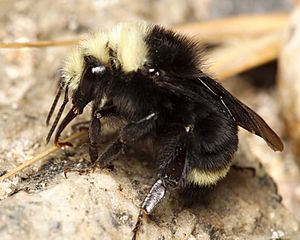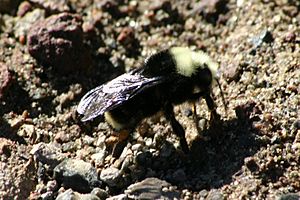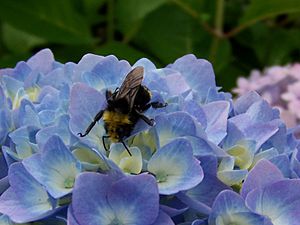Yellow-faced bumblebee facts for kids
Quick facts for kids Yellow-faced bumblebee |
|
|---|---|
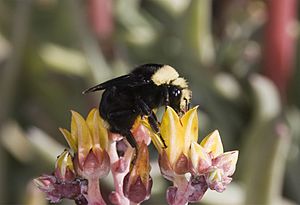 |
|
| Conservation status | |
| Scientific classification | |
| Genus: |
Bombus
|
| Species: |
vosnesenskii
|
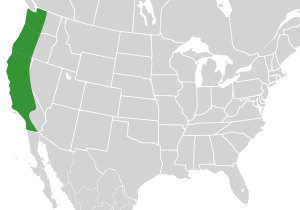 |
|
| The range of Bombus vosnesenskii. | |
The Bombus vosnesenskii, also known as the yellow-faced bumblebee, is a type of bumblebee. It lives along the west coast of North America, from British Columbia down to Baja California. This bee is the most common bee species in this area. You can find it in both cities and farms. Farmers also use B. vosnesenskii to help pollinate their crops, especially tomatoes grown in greenhouses. Even though its numbers are strong, building more cities can affect where it builds its nests. Also, this bee comes out early in the spring, which might make it harder for other bee species to thrive.
Contents
About the Yellow-Faced Bumblebee
The name Bombus comes from a Latin word meaning "buzzing" or "humming" sound. There are about 250 different kinds of bumblebees. They are grouped into 38 smaller categories called subgenera. These groups of bees look similar, even though they live in different places and act differently. Studies show that bumblebees are closely related to stingless bees and honey bees.
The yellow-faced bumblebee, Bombus vosnesenskii, belongs to the Bombus subgenus called Pyrobombus. Bees in the Pyrobombus group have short faces. This group is the largest of all the bumblebee subgenera.
What Does the Yellow-Faced Bumblebee Look Like?
The yellow-faced bumblebee has some special features. It has short, even hair. Its middle leg has a rounded joint. Its face is square-shaped. The hairs on its back legs form a special "pollen basket" called a corbicula. This basket helps the bee carry pollen.
- Queens are about 18 to 21 millimeters long.
- Worker bees are smaller, from 8 to 17 millimeters long.
- Male bees are 10 to 15 millimeters long.
All these bees have medium-length antennae and eyes that are similar in shape and size. They have black and yellow stripes. Queens and female workers usually have mostly black bodies with yellow stripes near their heads and on their fourth body segment (T4). Male bees look similar to females, but sometimes they have more yellow on their sides and further up their backs.
Where Yellow-Faced Bumblebees Live
The yellow-faced bumblebee is one of the most common bee species on the West Coast of the United States. It is the most common bumblebee from Oregon northward. They build their nests from British Columbia down to Baja California.
In the past, the western bumblebee (Bombus occidentalis) was the most common species. But diseases hurt their populations. The yellow-faced bumblebee has now become more common in those areas. However, in places like San Francisco, where B. vosnesenskii is very common, there are fewer other bee species. This might be because the yellow-faced bumblebee comes out early in the season. This allows it to find and claim nesting spots before other bees.
These bees build their nests underground. A typical colony has about 200 to 300 worker bees. Studies show that in cities, there are fewer B. vosnesenskii nests. This is because paved areas like roads and sidewalks make it hard for them to build their underground homes.
City Life and Nesting
Studies show that paved areas in cities reduce the number of yellow-faced bumblebee nests. This is likely because these bees nest underground. Pavement and other hard surfaces make it difficult for them to dig and find suitable nesting spots.
How Yellow-Faced Bumblebees Behave
The Colony Life Cycle
In the spring, a queen bee that has spent the winter sleeping (overwintering) wakes up. She then finds an underground nest. This is usually an old rodent burrow or a natural hole in wood or dirt. Once she finds a good spot, the queen lays her first batch of eggs. She keeps them warm by sitting on them. She gets energy for this from nectar, pollen, and honey she collects.
After about a month, the first worker bees hatch. These workers help the queen by finding food and keeping the new eggs warm. The colony grows for about a year, with more workers and male bees being born. Later, a new group of queen bees will hatch. When they are grown, they leave the nest to find mates. Then, they will sleep through the winter. In the spring, they will start their own new colonies.
Mating Habits
New queen bees and male bees are born at the end of the colony's life cycle. When the new queens are ready, they leave their nests to find mates. Male bees also leave their colonies. They fly around in patterns until they find a queen to mate with.
How Queens Help the Colony
At the beginning of the season, when the queen is young, she mostly focuses on keeping the eggs warm. But as the season goes on and the number of worker bees gets smaller, the queen starts to help more with finding food. She can even become the main bee that brings pollen and nectar back to the colony. Scientists think this change happens because the queen balances risks. When she is young, her job is more important for making new bees and building the colony. Finding food is risky. But later, when there are fewer workers, her job as a food collector becomes more important to feed the next generation of bees.
Keeping Eggs Warm
Yellow-faced bumblebee eggs cannot control their own temperature. But the queen bee keeps the egg clumps warm. She does this by pressing her abdomen (belly) against the eggs. She wraps her legs around the eggs to hold herself in place. When she does this, her abdomen gets much warmer. Her body also uses twice as much energy.
The queen does not have a specific temperature she aims for. She will keep the eggs warm even if the air temperature is high. If it's 30°C (86°F) outside, she will still warm the eggs. If it's 10°C (50°F), she might only raise the egg temperature to 26°C (79°F). However, she produces less heat when the air is already warm.
Keeping the eggs warm uses a lot of energy. So, the queen has to take breaks to eat. When she takes a break, the eggs cool down to the air temperature. But the eggs will still hatch, even if they are not kept warm all the time. The new worker bees will then help keep the next generation of eggs warm.
Keeping Warm While Flying
Like most bumblebees, yellow-faced bumblebees control their body temperature. They keep their bodies several degrees warmer than the air around them. When they are resting, their body temperature is close to the air temperature. To fly, bumblebees need to warm their flight muscles to over 30°C (86°F). In B. vosnesenskii, heat moves from the chest (thorax) to the belly (abdomen). This happens through changes in how their blood-like fluid (hemolymph) flows in the narrow part connecting the two body parts. When it's cold, the heat stays mostly in the chest. When it's hot, heat moves from the chest to the belly to help them cool down.
What Yellow-Faced Bumblebees Eat and How They Pollinate
What They Eat
These bees like to collect food from certain types of plants. These include:
How They Help Farmers
The yellow-faced bumblebee is very important for farming. Bumblebees are the main pollinators for tomatoes grown in greenhouses.
Scientists are still learning exactly how, but B. vosnesenskii pollinates greenhouse tomatoes better than humans can do by hand. Tomatoes pollinated by bees are often heavier, taller, and have more seeds. They are also generally better quality. One idea is that bees visit the flowers at just the right time. Humans might follow a set schedule that doesn't always match when the flowers are ready.
Bee Health and Parasites
The yellow-faced bumblebee can be affected by tiny organisms called parasites. These include a mite called Kuzinia and a tiny protozoan called Crithidia bombi. Both of these parasites affect individual bees, not whole colonies. They have been found often in B. vosnesenskii bees in California. These parasites can be found in many different types of bumblebees. Another parasite, Apicystis bombi, has also been seen, but not as often.
These parasites alone probably won't cause a big drop in bee numbers. But if bees are already stressed by other things, these parasites can make them less healthy.



